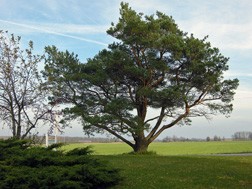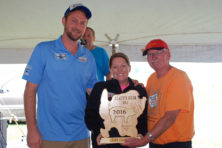Champion Trees of Door County
- Share
- Tweet
- Pin
- Share
Measuring big trees has been one of my passions for at least the past 55 years. My dad, who also had a deep interest in trees, spent a good many Sunday afternoons with me exploring the woods owned by some of his rural customers at his barbershop. The closest we came to finding a state champion was a large American Beech in Henry Baumgartner’s woods that measured about 12 feet in circumference, considerably larger than today’s champion. Sadly all of the big Beeches in those woods have been cut.
It was when I began teaching in Madison in 1955 that I joined the Wisconsin Academy of Arts, Sciences and Letters and had the good fortune of meeting Walter Scott (1911-1983) and making a special effort to sit next to him at many future Academy meetings. Scott was as well known for his volunteer activities as his outstanding work with the Department of Natural Resources and its predecessor, the Wisconsin Conservation Dept.
He spent decades working to develop a list of Wisconsin’s largest trees, and it was he who really turned me on to obtaining the correct instruments for accurate measuring of potential state champion trees. For many years Charlotte and I enjoyed receiving a Christmas card and personal note from Scott and his wife, Gertrude (Trudy). He was a great conservationist, preservationist and author who had a library of more than 5,000 books. I was truly overwhelmed, after his death, to receive as a gift from Trudy of one of Scott’s favorite and well-used books, The Tree Book (1907) by Julia Ellen Rogers. How I treasure and enjoy using this great volume.

The largest American Elm in Door County.
One of the first exciting features of the old-growth pine forest at Toft Point that Miss Emma was eager to show me was the immense “Big Pine” that grew along the Hollow Cedar Trail. Her close friend, Dr. Albert Fuller, chief botanist with the Milwaukee Public Museum, had aged Big Pine with an increment borer (in order to count its annual growth rings) in 1950 and found it be about 350 years old.
I had the pleasure of showing the tree to a group of junior high students from Sevastopol School just a few weeks before a raging wind storm toppled Big Pine in the fall of 1970. We possibly were the last to be able to witness this remarkable pine. Please read, “Big Pine’s Story” (p. 138) in my first book, Once Around the Sun, A Door County Journal.
Another person who has been an ongoing inspiration to locate and measure big trees is R. Bruce Allison, professional arborist for the past 40 years from Madison. We were lucky to be able to get him to put on one of our Thursday evening programs at the Ridges years ago, and it was then that he turned on a lot of people to search for big trees. Among the several books he has written is his latest, Every Root an Anchor: Wisconsin’s Famous and Historic Trees.
Surely it was Emma Toft’s love for her big pines and other trees that led some of us members of our “Friends of Toft Point” group to begin seriously searching for and measuring big trees in Door County. To date we’ve measured 150-plus trees of 34 different species.
This is a continuing project in which we list as many as 10 trees for some of the most common species. When the biggest (according to record points) tree is replaced by a new larger specimen, then we will remove the smallest of this group from the list. The most measured species have been White Ash, Eastern White Cedar, Eastern Cottonwood, Sugar Maple and White Pine.
Here are the pieces of equipment I use for obtaining a tree’s measurements: (1) Hypsometer. The model, given to me as a birthday present several years ago by close friends, is an Opti-logic 100 LH. It is a very fast, accurate and easy-to-use digitized instrument. (2) Tape measures – I use two; one is a 50-foot model used primarily for measuring the tree’s circumference. The second is a 200-foot model used for determining the crown spread of the tree. (3) a GPS unit used to obtain the tree’s exact location, in terms of latitude and longitude, so the tree can be easily located at a future date. (4) A digital camera is important for getting good images of the tree and the environment in which it grows.

Wisconsin’s champion Ironwood tree on Washington Island.
There are three different measurements of a tree that are totaled to obtain that tree’s record number. The tree’s circumference in inches, measured at 4 1/2 feet above the ground, is added to the tree’s height in feet, measured to the nearest foot, and this total is then added to one-fourth of the average crown-spread of the tree, measured in feet. The widest crown-spread (close to the trunk) is added to the narrowest crown-spread (also close to the trunk and at about a right angle to the widest measurement). The total of these two crown-spreads is divided by two to get the average and then multiplied by .25 to obtain one-quarter of the average. These three measurements, added together, give you the total points for the tree.
Naturally it gives many people pleasure in recognizing the largest of all trees in Door County, which happens at present to be the awesome Eastern Cottonwood growing next to the Institute Saloon in Institute. Its circumference is 267 inches (about 22 and a quarter feet), height is 114 feet, and its average crown-spread is 25 ft., resulting in a record number of 406 points. Two other Cottonwoods are close on the champion’s heels: the tree on the Ellison Bay hill (Hwy. 42) with 393 points, and one along E. Carnot Road with 382 points.
What an exciting honor it is to measure a tree and learn that it’s a new state champion. Thus far our group has been informed of and measured three: a Horsechestnut and an Ironwood on Washington Island, and a Sugar Maple having a circumference of 200 inches and a height of 86 feet, growing on Roger Anderson’s land in south Sturgeon Bay.
Just imagine, Door County having the state’s champion official tree, the Sugar Maple, gracing its land! It’s estimated that this venerable veteran is 350 years old and began growing in 1663! I must add that at present this record is still unofficial until verified by the “experts.”

An unusually shaped Scots Pine having a short trunk.
Oaks are always exciting to measure. Our Red Oak champ’s circumference is 146 inches. This beauty with a very wide crown grows in the cemetery a few miles south of Egg Harbor along Hwy. 42. The biggest White Oak is in our friend Roy Delwiche’s woods growing near the southern boundary of Door County. This tree’s circumference is 149 inches (12-plus feet) and its height is 86 feet; this beauty receives the finest protection imaginable from Delwiche.
Some of our best finds have come about purely by serendipity, such as the champion American Elm seen one summer as we rode our bicycles along the Ahnapee Recreational Trail south of Sturgeon Bay. Having a circumference of 180 inches (15 feet) this incredibly gorgeous tree appears to be in excellent health, which is unusual in light of the fact that most American Elms in our country have died within the past 50 or more years.
The 90-foot-tall county champion American Beech growing in the White Cliff Fen is now cared for by its new owners the Door County Land Trust. The two co-champion Eastern White Cedars grow at the Newport State Park and surely will continue to be in good hands.
I would appreciate being informed of trees you know of which you think should be measured for possible record status. Experience has taught us that often the biggest trees are growing unnoticed in someone’s backyard!


